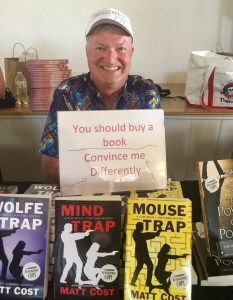Lea Wait's Blog, page 69
March 3, 2023
The Magic of Changing Places
Kate Flora: If this were any other March, my husband Ken and I would have recently completed our marathon drive to Florida, where we would spend the month. We would have spent those hours on the road listening to a novel—probably Dickens—and arrived at our rental with a sigh of relief. Alas, Sanibel Island, where we have rented for many years, was nearly destroyed by Hurricane Ian. So this year, because winter is too long and we feel the need to get away, we’re going west.
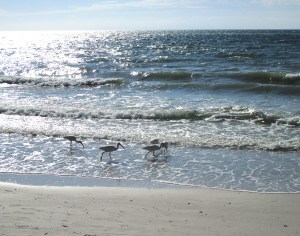 I’ve blogged before about the value of being in new and different places and seeing new things. There’s something about different weather and about temperatures that are different from New England in March that can be inspiring. So can seeing different vegetation, different animals, and different types of houses. Botanical gardens will have different plants. People’s yards will have different landscaping. Restaurants may feature different ethnicities. There is so much to observe in a new place, or a different one.
I’ve blogged before about the value of being in new and different places and seeing new things. There’s something about different weather and about temperatures that are different from New England in March that can be inspiring. So can seeing different vegetation, different animals, and different types of houses. Botanical gardens will have different plants. People’s yards will have different landscaping. Restaurants may feature different ethnicities. There is so much to observe in a new place, or a different one.
As a writer, I find these changes of scene particularly valuable. There’s a kind of brain reset that happens when I have enough concurrent days when I don’t finish my morning coffee and amble over to my small, crowded office where my unending to-do list confronts me. The light coming through the windows will be different. The views outside the windows will as well. There will be new smells and sounds and sometimes even the leaves on the trees will sound different when the wind blows.
When I used to teach writing (something I miss, by the way) one of the exercises I would  give my students was to have them carry index cards with them (or a small notebook) and write down things that they observed. Often, at the second class, having been given this assignment, some of them would come in and say they hadn’t seen anything. I would ask if they used headphones or earbuds and usually got a yes. “You have to unplug,” I’d say. “Writers are observers.” And then I could tell that despite what their mothers had told them about minding their own business, their passion for writing was a license to be nosy.
give my students was to have them carry index cards with them (or a small notebook) and write down things that they observed. Often, at the second class, having been given this assignment, some of them would come in and say they hadn’t seen anything. I would ask if they used headphones or earbuds and usually got a yes. “You have to unplug,” I’d say. “Writers are observers.” And then I could tell that despite what their mothers had told them about minding their own business, their passion for writing was a license to be nosy.
I am sure that some of them were shocked. But being nosy is one good way to collect places, and characters, and voices. My writing partner, Joe Loughlin, used to say it was important to try and involve all the senses, and he was right. Another exercise I used to give my students was to choose a place and describe it three times, each time using only one isolated sense. It could be a revelation to aspiring writers to break the process out like that and see what they discovered. I called it “tuning up their observation skills.”
 A few years ago, my husband was shocked when I started vacationing without my laptop. Before that, it always seemed that book arrived from my publisher either just as I was leaving for vacation or while I was away. And as some of you know, publishers always want the manuscript turned around in a week. I even carried it in my backpack on a hike through the Czech republic. I am not taking Mr. Laptop on any more hikes, but he’ll definitely be coming to Utah and Arizona with me. I hope he’ll have a good time and not try to be too productive.
A few years ago, my husband was shocked when I started vacationing without my laptop. Before that, it always seemed that book arrived from my publisher either just as I was leaving for vacation or while I was away. And as some of you know, publishers always want the manuscript turned around in a week. I even carried it in my backpack on a hike through the Czech republic. I am not taking Mr. Laptop on any more hikes, but he’ll definitely be coming to Utah and Arizona with me. I hope he’ll have a good time and not try to be too productive.
So in a few days I am off. It will be so sad to miss lounging by the pool and long beach walks every evening just before the sun went down. I’ve worked on a lot of books on Sanibel over the years. Sometimes I wonder whether the warm weather might have mellowed Joe Burgess as he gets older and grouchier. Maybe someday I’ll go back and reread the whole series and see if those I worked on in Florida, or on Bailey Island, feel any different.

March 1, 2023
How Many Milch Cows?
Kaitlyn Dunnett/Kathy Lynn Emerson here, once again deeply engrossed in genealogical research. Now that I have the time to explore Ancestry.com more thoroughly, I’m discovering wonderful treasure troves of useless information. A big time-waster? Probably, but to my mind it’s much more fun than spending the same number of hours on Facebook or Twitter or TikTok or playing games online.
So what am I into now? Tax rolls. Notices of sheriff’s sales. And my current fascination, the non-population, aka agricultural census schedules. These were taken in 1860, 1870, and 1880 and recorded information on farms. Since most of my ancestors in the U.S. in those years were farmers, they kept popping up in searches until I finally took a look at one and got hooked.

Old Hickory Farm, Ferndale, New York
Like all old records, they aren’t always complete and some years seem to have been skipped for certain people (or perhaps their names were so illegible that they aren’t turning up in searches done with the correct spelling). In some cases, the first page of the schedule is there, but not the second. Even with those gaps, I discovered quite a bit about four of my great-great grandfathers, all of whom lived in Sullivan County, New York in the second half of the nineteenth century.
The 1860 non-population census included John G. Gorton of Ferndale, one of the great-great-grandfathers. In 1860 he owned 80 improved and 195 unimproved acres of land valued at $4,800. He also had two horses, four milch cows, two oxen, nine other cattle, and thirty sheep. His livestock was valued at $600 and his personal estate was valued at $1,500. Tunis Misner of Liberty, whose daughter would later marry John’s son, farmed 75 improved acres and 25 unimproved valued at $5,000. He had two horses, eight cows, two oxen, two other cattle, and eight sheep, valued at $650.
On the maternal side of my family, great-great-grandfather Isaac Applebee owned real estate in Parksville valued at $500 and had a personal estate of $250. The non-population schedule gives him 5 improved and 120 unimproved acres of land. The value of his farm implements and machinery was $15 and he had one cow, two working oxen, and one swine, valued at $125.
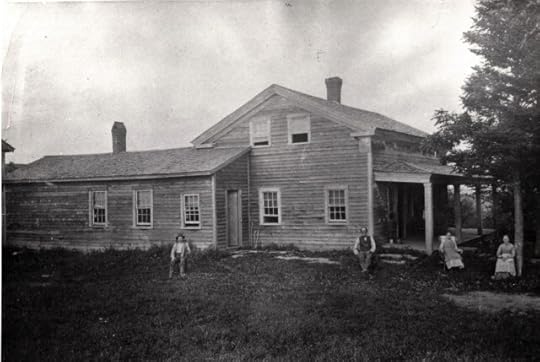
Hornbeck farm, Hurleyville, New York
Meanwhile, Lawrence Hornbeck of Hurleyville, whose son would later marry Isaac’s daughter, had real estate valued at $1000 and a household that included two servants. Lawrence farmed 38 improved acres and 45 unimproved. He had one horse, four cows, two oxen, three other cattle, six sheep, and one swine, valued at $200. In the previous year the farm had produced fifty bushels of rye and fifty bushels of oats.
The non-population schedules for 1870 also included Lawrence and Isaac. Lawrence listed 50 improved acres and 25 of woodland for a value of $1600 and owned farm implements and machinery worth $50. He owned two horses, six milch cows, two working oxen, eight other cattle, four sheep, and two swine. The value of all his livestock was $800. He produced 100 bushels of Indian corn and the same of oats and ninety bushels of buckwheat.
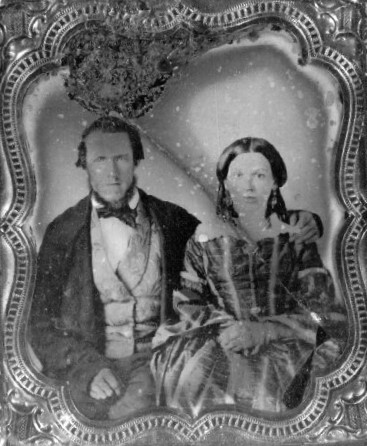
Isaac and Mary Applebee
Meanwhile Isaac Applebee had moved his family from Parksville to Hurleyville. In 1870 his farm contained 100 improved acres and 50 acres of woodland and was valued at $3,400. Farm implements and machinery were worth $100 and he paid $300 in wages during the year, including the value of board. He had two horses, fifteen cows, three other cattle, two sheep, and five swine. The value of all his livestock was $1,100. His land produced twenty bushels of rye, fifty of Indian corn, 250 of oats, and 150 of buckwheat.
Isaac and Lawrence are also in the non-population schedule for 1880. Isaac had 60 tilled acres, 80 acres in permanent meadow or pasture, and 30 in woodland. The value of land, buildings, and fences was $4,000. Farm implements and machinery were valued at $250 and livestock at $700. He paid $70 in wages. The value of production was $1,000. He planted 50 acres in hay and mowed 50 acres. He had two horses, two oxen, fifteen cows, and nine other cattle and sold fifteen still living. He sold 6,000 gallons of milk in 1879. On hand on June 1, 1880 were forty barnyard poultry and four other poultry. They produced 160 dozen eggs in 1879. Seven acres were planted in buckwheat (150 bushels), four in Indian corn (125 bu.), five acres in oats (120 bu.), two acres in rye (20 bu.), one acre in potatoes (100 bu.), and two acres in apples (100 trees; 100 bu.). The total value of orchard production was $15. He also cut twenty cords of wood in 1879, valued at $40.
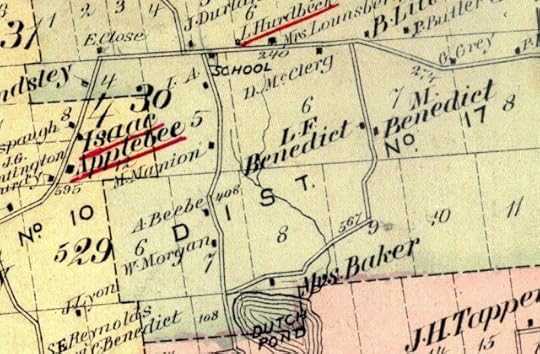
Lawrence Hornbeck, who lived no more than a mile away, tilled 28 acres, left 27 untilled, and had 20 acres that were woodland. The value of the land, including buildings and fences, was $2000. The value of farm implements and machinery was $200 and the value of all livestock was $480. In 1879, he spent $20 on building and repairs and $20 in wages, including value of board. The estimated value of all farm produce sold, consumed, or on hand was $650. Twenty acres were mown and twenty acres were not mown. Twenty-two acres were planted in hay. He owned two horses, eight cows, three other cattle, two swine, and fifteen barnyard poultry. In 1879, the farm had produced 700 pounds of butter and sixty dozen eggs.
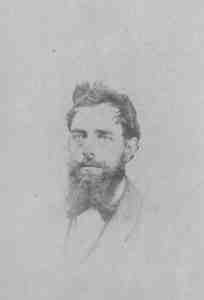
Nathaniel Gildersleeve Gorton in 1872
John Gorton’s son, Nathaniel Gildersleeve Gorton (my great-grandfather) also shows up in the 1880 non-population census, where he was listed as Gildersleeve Gorton, owner. This was the same farm that had once belonged to his father and now consisted of 113 improved acres and 40 unimproved. The value of farmland and buildings was listed as $5,000. His farm implements and machinery were valued at $200 and his livestock at $1,200. In 1879, he spent $50 on building and repairs. The estimated value of all farm productions, sold, consumed, or on hand was $150. Thirty-five acres of his land were mown for hay and on June 1, 1880 he owned one horse but no mules or asses.
Useless information? Maybe. But the details are evocative, and if someone happened to be writing about that period of history . . .

Kathy Lynn Emerson/Kaitlyn Dunnett has had sixty-four books traditionally published and has self published others, including several children’s books. She won the Agatha Award and was an Anthony and Macavity finalist for best mystery nonfiction of 2008 for How to Write Killer Historical Mysteries and was an Agatha Award finalist in 2015 in the best mystery short story category. She was the Malice Domestic Guest of Honor in 2014. Her most recent publications are The Valentine Veilleux Mysteries (a collection of three short stories and a novella, written as Kaitlyn) and I Kill People for a Living: A Collection of Essays by a Writer of Cozy Mysteries (written as Kathy). She maintains websites at www.KaitlynDunnett.com and www.KathyLynnEmerson.com.
February 28, 2023
The Guest Who Came in from the Cold
Irene M. Drago: Last summer, I spied two crime writers at the Railway Village in Boothbay. Kate Flora and Jule Selbo were sitting behind a table covered with stacks of their top selling mysteries, and I was sitting a few authors away. We were all waiting for the heralded Books in Boothbay to begin. The hands on the clock mounted high on the Meeting House wall informed me we had five minutes to showtime, so I made a beeline to Kate. Why Kate not Jule? Well, that’s a key point in my first blogpost as a guest of Maine Crime Writers.
Boothbay. Kate Flora and Jule Selbo were sitting behind a table covered with stacks of their top selling mysteries, and I was sitting a few authors away. We were all waiting for the heralded Books in Boothbay to begin. The hands on the clock mounted high on the Meeting House wall informed me we had five minutes to showtime, so I made a beeline to Kate. Why Kate not Jule? Well, that’s a key point in my first blogpost as a guest of Maine Crime Writers.
In Maine, authors tend to form a Congo line as they move from one event to another. When we shake the hand of one author, they turn and introduce us to another. And just like that, we connect and begin to support each other. I met Bruce Robert Coffin at the Poland Spring Strawberry Festival in 2018. As we signed books from morning to dusk, we chatted about the writing life. During that conversation, the former detective sergeant mentioned Kate Flora. He said she was one of his greatest mentors, and I sensed his sincerity. In 2020, when COVID–19 cancelled all our events, I asked Bruce if he’d be willing to interview me about my new novel via a Webinar with Curtis Memorial Library. He said yes and that virtual event was the best conversation I’ve ever had about The Maine Point.
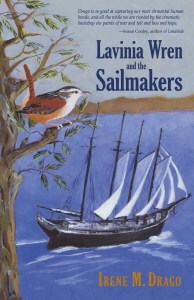 Are you wondering how I’m going to weave Kate Flora and Jule Selbo into this blogpost? Am I creating a mystery? I hope so because since moving to Maine I’ve come to believe that mystery writers rule. Over the last six years, I’ve had the pleasure of getting to know Bruce, Maureen Milliken, Charlene D’Avanzo, and Matt Costa, and the more I learn about Maine Crime Writers, the more I want to be a Maine crime writer, but I write historical fiction. For better or worse, the M in Irene M. Drago does not stand for mystery. Nevertheless, my conversations with Bruce and other authors gave me the courage to walk up to Kate Flora at Books in Boothbay and say, “Hi, Kate, my name is Irene Drago.” And much to my surprise, she replied, “I’ve heard that name before.” Then she introduced me to Jule Selbo, and I felt embraced. Within five minutes, Jule suggested I write a blog as a guest of MCW. I shook my head and told her I didn’t write mysteries, but she was ready for that response and invited me to write about my process. In a blink, Jule convinced me to be a guest blogger among some of the coolest authors I know.
Are you wondering how I’m going to weave Kate Flora and Jule Selbo into this blogpost? Am I creating a mystery? I hope so because since moving to Maine I’ve come to believe that mystery writers rule. Over the last six years, I’ve had the pleasure of getting to know Bruce, Maureen Milliken, Charlene D’Avanzo, and Matt Costa, and the more I learn about Maine Crime Writers, the more I want to be a Maine crime writer, but I write historical fiction. For better or worse, the M in Irene M. Drago does not stand for mystery. Nevertheless, my conversations with Bruce and other authors gave me the courage to walk up to Kate Flora at Books in Boothbay and say, “Hi, Kate, my name is Irene Drago.” And much to my surprise, she replied, “I’ve heard that name before.” Then she introduced me to Jule Selbo, and I felt embraced. Within five minutes, Jule suggested I write a blog as a guest of MCW. I shook my head and told her I didn’t write mysteries, but she was ready for that response and invited me to write about my process. In a blink, Jule convinced me to be a guest blogger among some of the coolest authors I know.
Now, on a cold winter day, I’m keeping my promise. In addition to expressing my 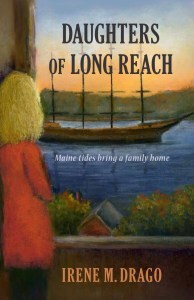 gratitude to the many crime writers who’ve encouraged me to stay the course and keep writing, I’d like to address the topic of process because that’s where we can find common ground. In order to write a compelling story, in depth research is a necessity. Before I begin a historical novel, I read every nonfiction book I can find that explores the time and place I want to create. Before I introduce the first character and begin a storyline, I peruse maps, photos, newspaper articles, journals, and letters that describe real people, places, and events in a particular time period. The research for Lavinia Wren and the Sailmakers, my latest novel, was extensive beyond measure because I met the granddaughter of one of the last captains and shipbuilders of schooners out of Thomaston, and she gave me incredible insight into the Dunn & Elliot Sail Loft—a fortuitous beginning.
gratitude to the many crime writers who’ve encouraged me to stay the course and keep writing, I’d like to address the topic of process because that’s where we can find common ground. In order to write a compelling story, in depth research is a necessity. Before I begin a historical novel, I read every nonfiction book I can find that explores the time and place I want to create. Before I introduce the first character and begin a storyline, I peruse maps, photos, newspaper articles, journals, and letters that describe real people, places, and events in a particular time period. The research for Lavinia Wren and the Sailmakers, my latest novel, was extensive beyond measure because I met the granddaughter of one of the last captains and shipbuilders of schooners out of Thomaston, and she gave me incredible insight into the Dunn & Elliot Sail Loft—a fortuitous beginning.
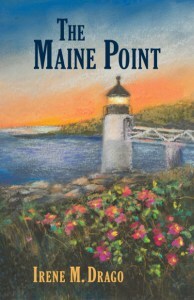 When I write historical fiction, my goal is to draw the reader into my characters’ world and lead them to believe that the characters might have lived. Lavinia might have talked and dressed just the way I describe her, and she might have felt the same joy and sorrow I spill onto the page. Recently, I received an email from a reader who wondered if Lavinia Wren was an actual person in history. The reader asked, “Did Lavinia attend Colby College and work for prison reform?” Though I was flattered, I had to tell her that Lavinia was completely fictitious, but some of the supporting characters were actual shipbuilders and sailmakers who lived and worked in Thomaston. I also told her that the storyline involving the prison—in Thomaston but not of it— was inspired by a real prisoner. Then I sweetened my reply by telling her that Charles Ranlett Flint, one of Lavinia’s closest friends, was my touchstone. Born in 1850, Charles was the son of a prominent shipbuilder and became enormously successful as a commission merchant. In fact, he was labeled the “Father of Trusts.” Historical fiction blends fantasy with reality and that’s an intriguing process.
When I write historical fiction, my goal is to draw the reader into my characters’ world and lead them to believe that the characters might have lived. Lavinia might have talked and dressed just the way I describe her, and she might have felt the same joy and sorrow I spill onto the page. Recently, I received an email from a reader who wondered if Lavinia Wren was an actual person in history. The reader asked, “Did Lavinia attend Colby College and work for prison reform?” Though I was flattered, I had to tell her that Lavinia was completely fictitious, but some of the supporting characters were actual shipbuilders and sailmakers who lived and worked in Thomaston. I also told her that the storyline involving the prison—in Thomaston but not of it— was inspired by a real prisoner. Then I sweetened my reply by telling her that Charles Ranlett Flint, one of Lavinia’s closest friends, was my touchstone. Born in 1850, Charles was the son of a prominent shipbuilder and became enormously successful as a commission merchant. In fact, he was labeled the “Father of Trusts.” Historical fiction blends fantasy with reality and that’s an intriguing process.
All of my stories are imbued with hope, but they are also peppered with flawed characters who struggle with the challenges of life and death. As a former teacher of language and literature, I often say we teach history through war. As a novelist, I prefer to pull the thread of love, not war, through history. If I’m looking for common denominators among mysteries and historical fiction, the exploration of good and evil comes to mind. Lavinia Wren is orphaned by the Civil War, but she survives because of love. My historical novels are multi-generational, family love stories, and every generation is impacted by war. That’s the cold reality, but this winter I’m a guest blogger for Maine Crime Writers, and I’m feeling the warmth of the Maine literary community. We will survive.
who struggle with the challenges of life and death. As a former teacher of language and literature, I often say we teach history through war. As a novelist, I prefer to pull the thread of love, not war, through history. If I’m looking for common denominators among mysteries and historical fiction, the exploration of good and evil comes to mind. Lavinia Wren is orphaned by the Civil War, but she survives because of love. My historical novels are multi-generational, family love stories, and every generation is impacted by war. That’s the cold reality, but this winter I’m a guest blogger for Maine Crime Writers, and I’m feeling the warmth of the Maine literary community. We will survive.
Irene M. Drago’s first novel, Daughters of Long Reach, won a Next Generation Indie Book Award and led to a sequel, The Maine Point. Both have earned her praise for creating historical fiction that rings true. Born in the shadow of the Brooklyn Bridge, Drago has always been fascinated with tugboats, schooners, U.S. Navy ships, and every kind of watercraft. After college, she worked for the Defense Department as a Russian analyst, earned a Master of Arts degree in Spanish language and literature, and taught at the high school and college level. She lives in Bath, Maine, the City of Ships. In the summer, she and her husband enjoy piloting their Maritime Skiff around Casco Bay and watching their grandchildren grow.
February 27, 2023
Mysteries That Feature Books
Charlene D’Avanzo: Although I’ve read lots of mysteries none focused on books. It’s no surprise though that quite a few whodunits do feature libraries and librarians, book groups, booksellers, and more. Here are some that use the silence, solitude, and eyes peering from the other side of the spines to good advantage.
Bottom line is that the quiet is only comforting until you want — no, desperately need — someone around to help you.
Here are a few novels to get you started:
The Woman In The Library by Sulari Gentill
When a scream shocks the quiet reading room at the Boston Public Library, security guards rush to investigate. Those inside must stay where they are until the area is secured. Four researchers in the reading room are now trapped together, each with their own suspicions and fears. This story-in-a-story novel is all about the frights and friends we can make between a library’s walls.
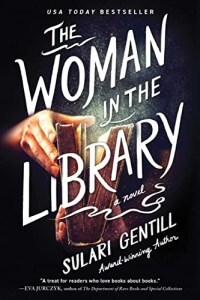
The Plot is Murder by V.M. Burns
Who doesn’t dream of owning a mystery-filled bookstore? Samantha Washington is preparing to open exactly that while also writing a mystery of her own. But, when a realtor ends up dead n her backyard, suspicions turn her way. Samantha does, admittedly, know a lot about crimes. Before she can open the store of her dreams and finish her book, Samantha teams up with a group of retirees, including her grandmother, to solve the case.
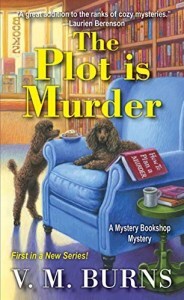
Murder By The Book by Rex Stout
When everyone who has read Leonard Dykes’s unpublished manuscript -including the author himself – is found dead, brilliant and eccentric Nero Wolfe, along with his sidekick, decides to set a trap.
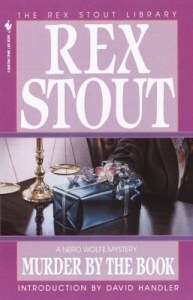
Bury Your Dead by Louise Penny
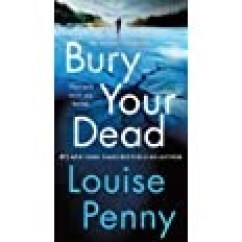
An eccentric researcher is found dead in the basement of the Literary and Historical Society in Quebec City. Shrewd Chief Inspector Armand Gamache investigates.
February 24, 2023
Weekend Update: February 25-26, 2023
 Next week at Maine Crime Writers there will be posts by Charlene D’Avanzo (Monday), special guest Irene Drago (Tuesday), Kaitlyn Dunnett/Kathy Lynn Emerson (Thursday), and Kate Flora (Friday).
Next week at Maine Crime Writers there will be posts by Charlene D’Avanzo (Monday), special guest Irene Drago (Tuesday), Kaitlyn Dunnett/Kathy Lynn Emerson (Thursday), and Kate Flora (Friday).
In the news department, here’s what’s happening with some of us who blog regularly at Maine Crime Writers:
February 28 is your last chance to snag Maggie Robinson’s cozy, 1920s-set Nobody’s Sweetheart Now for $1.99. Blurb, first chapter, and buy links: Nobody’s Sweetheart Now | Maggie Robinson
Matt Cost has had the second book in the Mainely Mystery series, Mainely Fear, released into the wild on Audiobook.
This series is also highlighted in an article that Cost did for Digital Publishing that will be published on March 6th. It is about the transformation from bookstore owner to writer. Thirty years ago, he owned a mystery bookstore in Brunswick, Maine called The Coffee Dog Bookshop. That bookstore lives on in the Mainely series, as the protagonist, Goff Langdon, is a PI and a mystery bookstore owner.
Cost recently was on a radio panel discussing the effect that AI is and will be having on writers, authors, and books. Check out the panel of the Bonnie Graham Technology Revolution and can be viewed HERE.
Kate Flora recently introduced a great short program for the Sisters in Crime New England chapter on Shortcast, a short program for producing podcasts that is perfect for the intimidated. Check it out here: https://www.youtube.com/watch?v=yayf2UEZGHE
Kate Flora: And I just got the cover for a collection of short crime stories designed to showcase the contributors series books titled: A Sampling of Sleuths.

An invitation to readers of this blog: Do you have news relating to Maine, Crime, or Writing? We’d love to hear from you. Just comment below to share.
And a reminder: If your library, school, or organization is looking for a speaker, we are often available to talk about the writing process, research, where we get our ideas, and other mysteries of the business, along with the very popular “Making a Mystery” with audience participation, and “Casting Call: How We Staff Our Mysteries.” We also do programs on Zoom. Contact Kate Flora
February 23, 2023
Oh, I’m Too $@#! Old for That
In 2004, I was a Fishtrap Fellow at the Fishtrap Writers’ Conference in Joseph, Oregon. The theme of the conference was “Writing and the West,” and included poets, fiction writers, songwriters, and anyone else who had anything to say about living in and creating in the Western half of the country. I remember most clearly meeting 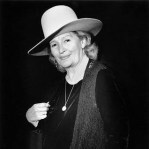 Rosalie Sorrels, a folksinger who’d played with Dave Van Ronk, Utah Phillips, and Pete Seeger. She was 71 at the time, and I don’t know if I ever said it to her out loud, but I surely thought “I want to be just like you when I grow up.”
Rosalie Sorrels, a folksinger who’d played with Dave Van Ronk, Utah Phillips, and Pete Seeger. She was 71 at the time, and I don’t know if I ever said it to her out loud, but I surely thought “I want to be just like you when I grow up.”
Notwithstanding the question about whether I ever grew up, what I meant at the time was I wanted to emulate her easy way with her art, her sense that no one much cared what you did so you might as well do what you wanted, and her willingness to share what she knew with anyone who showed the slightest spark of interest. Her creative spark was as alive then as it had been in her youth, playing guitar in the cafés of New York.
I’m a lot closer to 71 now than I was then (obviously), but I find I’m still looking for the mentors to carry me later into my seventies, on into my eighties, and sans creek-rising, the nineties and beyond. Who are they?
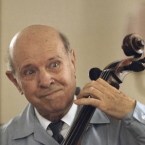 Pablo Casals, who practiced his cello four or five hours a day into his eighties, because, as he said “I think I’m beginning to see some improvement.”?
Pablo Casals, who practiced his cello four or five hours a day into his eighties, because, as he said “I think I’m beginning to see some improvement.”?
Eubie Blake, the jazz musician who played and recorded until he died at 96?
Harriet Doerr, who published her debut novel at the age of 74?
Georgia O’Keefe, who went blind at 84, but continued to paint until she died at 98?
I teach older adults and I’m always troubled by the fact that so many people in that cohort don’t think of themselves as creative. Many have lived lives of great achievements in business, education, family life, and yet they don’t see the spark that made them alive through their work. Worse, they think they are too old to create any more, too old to pick up a paintbrush, a pen, a hammer and chisel.
What works in their favor, if they could see it, is the shedding of some of the daily responsibilities: commuting, working, childrearing, the expectations of others. Time becomes more abundant as we age, though it moves a hell of a lot faster. But it is nothing to take a little time for yourself and create something. Write a poem, knit a scarf, tie a fly. The product doesn’t have to be beautiful and it doesn’t have to be extraordinary. But the impulse needs breathing space. It is nothing to create, and it is everything.
Will AI replace fiction writers? No. You’re welcome.
Maureen Milliken: I decided to take the day off from writing a post and have artificial intelligence do it instead.
Kidding!
But I’m sure many writers have had the same experience I have — that smug guy (it’s always a guy, sorry fellas), who seems to look for reasons to diminish or patronize your writing by coming up with “reasons” it won’t succeed. I don’t know about you, but it’s been happening since I started writing my first book, and now that I’m on my fourth one, it still happens. Twice in the past few months I’ve been asked by different acquaintances some version of “What are you going to do when AI is writing all the books?”
My answer? Gosh, I guess I’ll strap on my jet pack, move to Mars and start the hologram pet cat business I’ve always dreamed of.
Kidding again! My out-loud answer is “I’ll just keep doing what I’m doing. It’s not my problem.”
There are definitely some writing careers that AI could surplant. Since it draws information from the internet (though not always accurately), writing jobs that revolve around gathering information and disseminating in a way designed to get online clicks are probably the best use. I’m not talking about journalism, which when it’s done right involves critical thinking and judgment calls, but rather the kind of stuff you see all the time like “10 reasons you should embrace AI” Or “The top five all-time best movies” or “25 things you can make with tofu.”
As a fiction writer, I look at AI the same way I look at all the other “competition”: Not my problem. I saw a statistic recently that about 4 million new book titles come out a year, with 500,000 to 1 million traditionally published, and the rest independently published. If people start publishing AI books, that’s just more into that mix.
Some of those millions of books published every year are really good, some not so much. Some really good books never make it onto anyone’s radar. Some mediocre ones become big sellers.
You can’t worry about it when you’re writing. The only thing you should worry about is your own stuff and making it the book you want it to be.
I was at an author event a few years ago where an aspiring writer fretted to a panel that some bigger, better writer was writing a book with the same premise as hers. Should she find something else to write about? It’s a common concern when you’re starting out. My first book starts with a body found in a melting snowbank. Every time someone came across a book with a body in a snowbank, they’d let me know. I’d be like, “Uh oh, should I change my book?” The answer was, of course, no.
The thing is, you can have a dozen writers in a room, give them a prompt for an idea, and get 12 wildly different stories. None will be the same. Some will be good, some will be bad. The different outcomes all depend on how the writer’s brain works and their real, human intelligence, along with their imagination, experiences, perceptions of the world around them, and more. If you have AI as the 13th “writer” in the room, its product will probably be a little better than some (I mean you, people who don’t know punctuation, sentence structure, etc). But it will probably be worse than most as far as being interesting, character development, voice, dialogue, and all those things that come out of your writer brain.

Me and James Joyce in Dublin in August. Or rather, a statue of James Joyce. The real person would have a lot more to him.
Voice is one of those often overlooked, but really most important things about individual writing. That is, once you’ve mastered the basic rules and can string sentences and words together in a way that makes sense. Voice comes right from the writer. Voice imitators are obvious. I was a judge in a national contest for self-published writers for several years and unique voices stood out. Some didn’t have voice at all, but were simply rote writers. Technically they were OK, but the books were boring. Many tried to imitate that annoying buddy movie style (think “I’m too old for this [expletive]” every time something bad happens, a line I read in hundreds of books). It didn’t work because it was an imitation, probably from writers who watched more movies and TV than read books.
Another writer’s book was a garbled mess. In my critiques, I always tried to do the postive-negative-positive sandwhich, keeping in mind that while I was reading hundreds of these, this is the one book this person has written and it’s dear to their heart. I gently (honest!) pointed out that sentences had to make sense if you’re going to get your point across to the reader. The writer responded angrily that James Joyce got away with it. My first reaction was “I KNOW James Joyce and you, sir, are not James Joyce.” That’s not what I said. What I said was something like, Joyce knew the rules and any rule-breaking was for a reason. I took a semester of Joyce in college and it was brutal, but illuminating. He’s grown on me over the years. I don’t think this guy was trying to imitate James Joyce, I think he just didn’t care enough to know what he was doing.
Does AI “care”? It’s not a question that I feel I need to spend any time pondering. But inauthentic voice, which AI would have to have, often falls flat.
To belabor the whole thing with a metaphor, it’s comparing the James Joyce statue in Dublin with the real guy. The statue looks like him, but that’s about it. It’s not him. AI fiction writing may look like fiction writing, but, from what I’ve seen, doesn’t have the heart, soul and breathing life that something produced by a human would.
Sure, smug guy who wants to see writers fail will point out, but they’ll perfect it to the point where no one can tell the difference! Gotcha!
No, not got me. Haven’t you been reading this at all? (It’s probably the same smug guy who likes to approach writers at tables where they’re selling books to announce, “I don’t read!” It’s something that happens with alarming frequencey. I just smile and say, “Your loss.”)
I try to imagine someone who publishes a book with AI trying to pitch it to an agent or publisher. If you care so little about what you’ve “written,” if you’re that disengaged, how will you convice anyone else to care?
I know the answer to that is that plenty of writers have done it. Yes they have. I’ve seen writers who do very well, but look at writing as simply producing content that people will buy. In that sense, AI is no different.
I’m sure that people will start creating books with AI. I’m sure some will get published. I’m sure readers will buy those books. Just like countless other books that I take a look at and think, “Seriously? Ugh.”
I don’t care. Let them do it, whether they’re produced by AI or anyone else. It doesn’t have anything to do with me. No one will write the book I’m writing. AI won’t and no one else will, either. Good or bad, it’s all mine. Same with the one you’re writing.
So, no need to buy a jet pack or wait until travel to Mars is a thing, or even consider a more immediate career change because of AI. If you enjoy writing and care about it, carry on. AI is not our problem. You’re welcome.
February 22, 2023
Win a Book Wednesday!
Maggie Robinson here, feeling flush with money. Last of the big-time spenders, that’s me. I have a whole ten-dollar bill burning a hole in my handbag, ready to take advantage of the sale of Nobody’s Sweetheart Now. It’s the first volume in the cozy Lady Adelaide Mysteries, and is currently only $1.99 through the end of February. If you’d like a free download, just contact me at maggie@maggierobinson.net. The first five folks will win a book for their Kindle from Amazon. And don’t worry, I will not add you to any list or use your address for any nefarious purpose, or any purpose, period. Cross my heart and hope to die.
To pique your interest, here’s the first chapter and information from its book page. If you don’t think this is quite your cup of tea (contrary to Rhys Bowen), or have read it already (bless you) I can send a friend or family member a book if you prefer. Ready, set, go!
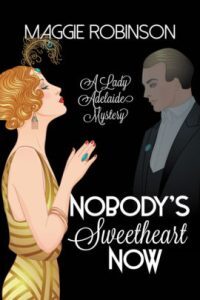
February 21, 2023
The Roaring ‘20s by Matt Cost
The Roaring ‘20s was quite arguably the most exciting time in the history of the US. It was a time just after the Great War, women recently having got the right to vote, Prohibition, speakeasies, rum runners, gangsters, baseball, jazz, moving pictures, and a period of fantastic writers producing books.
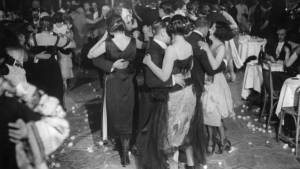
Paris has always been spoken of as a hot spot in this time period for all of this, but New York City was filled with legendary figures and events like no other place and time in the entire world. Dorothy Parker and the Algonquin Round Table, F. Scott and Zelda Fitzgerald and the start of The Great Gatsby, Babe Ruth and the New York Yankees VS the Brooklyn Trolley Dodgers, Coleman Hawkins, Ethel Waters, Louis Armstrong and so many other monumental jazz musicians; these are just the tip of the iceberg that was New York City in the 1920’s.
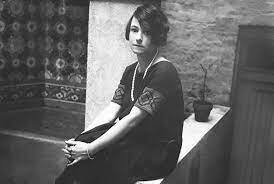
When I decided to combine my love of history with my passion for mystery, thus, I needed to look no further than a setting of Brooklyn in the ‘20s. It didn’t hurt that I have a daughter living in Bed-Stuy there in the city, giving me the opportunity to research as well as visit. I decided to base my PI, 8 Ballo, in the next neighborhood over in Bushwick, based off a graffiti tour I participated in, and Velma Gone Awry; a Brooklyn 8 Ballo Mystery, set in 1923, was born.
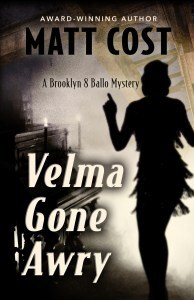
The starting point is a German businessman coming into the dingy PI office of 8 Ballo and hiring him to find his missing flapper daughter. 8 will learn through the course of the search that the twenty-five-year-old Velma is an incredibly talented young lady. And perhaps she is missing on her own volition, hiding from something in her past. It is also possible she’s been abducted by the Jewish gangsters Bugsy Siegel and Mayer Lansky.
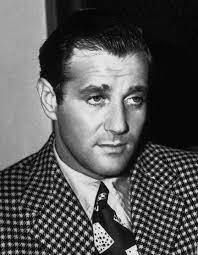
The investigation leads 8 to befriending Dottie Parker, conversation with Scott and Zelda Fitzgerald, meeting with Coleman Hawkins and Smack Henderson, and being threatened by Siegel and Lansky. And that is just the first day. In the days that follow, other legendary figures such as Babe Ruth, Ethel Waters, and Mae West will be encountered in the search, all having connections to the intriguing Velma.
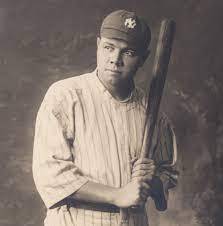
8 Ballo got his curious moniker when his mother was certain that he was going to be born a girl that she had the name Margrit picked out, but no male name. When he was born a boy, and his dad was out to sea, she merely wrote the number 8 down on the birth record, meant as a placeholder to be changed later, but never was. He is college educated, a veteran of the Great War, is in his mid-30’s, and has relationship issues.
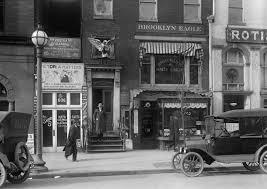
He is aided in his investigation by a colorful group who represent the melting pot that is 1920s Brooklyn. His best is Pearle Hill, a business entrepreneur he has known since they were boys playing stickball on the streets around the turn of the century. Marty Feldman is a journalist for the Brooklyn Eagle and Stephen McGee is a cop in Bushwick. 8 occasionally sees a woman by the name of Asta Holm, until the mysterious Velma complicates things.
Where is Velma and why has she gone awry? Follow 8 Ballo through the streets of New York City in the Roaring ‘20s to find the answers to these questions. Velma Gone Awry is publishing on April 12th. Read on. Write on.
Matt Cost was a history major at Trinity College. He owned a mystery bookstore, a video store, and a gym, before serving a ten-year sentence as a junior high school teacher. In 2014 he was released and began writing. And that’s what he does. He writes histories and mysteries.
Cost has published four books in the Mainely Mystery series, with the fifth, Mainely Wicked, due out in August of 2023. He has also published four books in the Clay Wolfe Trap series, with the fifth, Pirate Trap, due out in December of 2023.
For historical novels, Cost has published At Every Hazard and its sequel, Love in a Time of Hate, as well as I am Cuba. In April of 2023, Cost will combine his love of histories and mysteries into a historical PI mystery set in 1923 Brooklyn, Velma Gone Awry.
Cost now lives in Brunswick, Maine, with his wife, Harper. There are four grown children: Brittany, Pearson, Miranda, and Ryan. A chocolate Lab and a basset hound round out the mix. He now spends his days at the computer, writing.
February 20, 2023
And Don’t Forget the Dog!
Kate Flora: I have finally struggled my way into the end zone on a first draft of the eighth Joe Burgess procedural, Such a Good Man. It has truly been a struggle. The book is six months overdue to my publisher, something I never do. And unlike when I finish most books, I can’t tell whether it works or not.
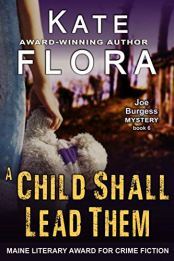 So what does all that have to do with a dog? Well, regular readers of the series will remember than in A Child Shall Lead Them, one of the bad guys had a dog named Fideau. When the bad guy went to jail, Fideau needed a new home, and somehow he ended up with Burgess. Probably because Burgess’s kids needed a dog. Instead, it appeared that in Fideau’s opinion, it was Joe Burgess who needed a dog. At the beginning of the seventh book, A World of Deceit, Burgess is on vacation, resting in a hammock and guarded by his dog, when a young girl appears, declares that her father is in trouble, and smashes that restful vacation to smithereens.
So what does all that have to do with a dog? Well, regular readers of the series will remember than in A Child Shall Lead Them, one of the bad guys had a dog named Fideau. When the bad guy went to jail, Fideau needed a new home, and somehow he ended up with Burgess. Probably because Burgess’s kids needed a dog. Instead, it appeared that in Fideau’s opinion, it was Joe Burgess who needed a dog. At the beginning of the seventh book, A World of Deceit, Burgess is on vacation, resting in a hammock and guarded by his dog, when a young girl appears, declares that her father is in trouble, and smashes that restful vacation to smithereens.
Over the course of the book, Burgess discovers that his new dog is very good at finding people. He also concludes that his dog can understand much of what he says and is sometimes able to speak. Evidently there is some serious bonding going on between man and dog.
Fast forward to Book Eight. I am deeply into the book before I realize that I’ve forgotten to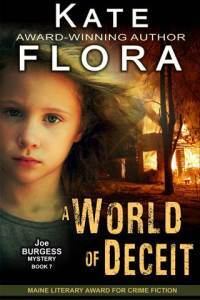 include Fideau. There are rules in the mystery writing community about this. Along with the never kill a cat or abuse a dog, there’s the rule that if you put an animal in a series, you can’t suddenly forget about it. The animal, like other recurring characters, has become not only a part of the writer’s repetoire, it has become another character readers have come to expect. At this point, I can no more leave Fideau out than I can leave out Terry Kyle or Stan Perry or Chris or Captain Cote or Burgess’s kids.
include Fideau. There are rules in the mystery writing community about this. Along with the never kill a cat or abuse a dog, there’s the rule that if you put an animal in a series, you can’t suddenly forget about it. The animal, like other recurring characters, has become not only a part of the writer’s repetoire, it has become another character readers have come to expect. At this point, I can no more leave Fideau out than I can leave out Terry Kyle or Stan Perry or Chris or Captain Cote or Burgess’s kids.
I suppose that Fideau is my aspirational dog. I don’t have a dog. We’ve always traveled too much to get one. But at this point, I have six granddogs, all of them rescues. I’ve spent a good deal of time in the world of dogs and dog training researching my nonfiction books Finding Amy, Death Dealer, and A Good Man with a Dog. As a result of this, I’ve come to see dogs, their personalities, their abilities, their training, and the way they can enhance life differently than I did before. Now I get to vicariously enjoy having a dog through Burgess’s experience.
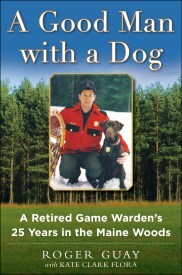 So, back to book eight. It was already late in the book, and Fideau had barely made an appearance. Now it was time to find a way to include him. That way was to help Burgess locate a missing girl who might be being threatened by a killer because of something she’d witnessed. Once again, Fideau didn’t let Burgess–or me–down, but was a perfect assistant first to help find the girl and then to comfort her while Burgess dealt with the killer.
So, back to book eight. It was already late in the book, and Fideau had barely made an appearance. Now it was time to find a way to include him. That way was to help Burgess locate a missing girl who might be being threatened by a killer because of something she’d witnessed. Once again, Fideau didn’t let Burgess–or me–down, but was a perfect assistant first to help find the girl and then to comfort her while Burgess dealt with the killer.
No, Fideau, you were not forgotten. But there’s a lesson here, and its one I learned long ago in my first Joe Burgess book, Playing God. In my early drafts, I opened the book with a rookie cop on patrol on an icy February night finding a body in a parked car. I realized, through feedback from my beta readers, that by opening the book with Remy Aucoin instead of Burgess, I gave readers the impression that the book was going to be about Remi. I had to fix it so the book opened with Burgess.
There are so many things to consider, juggle, and keep track of when plotting and writing a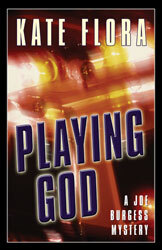 book. If you are more of a pantser, like me, who has sketched out the book in her head but discovers much of the story while writing, it is vitally important to keep notes as you write and as you edit, so your timeline and your cast of characters and what you’ve revealed about them, makes sense. And so you don’t forget the dog.
book. If you are more of a pantser, like me, who has sketched out the book in her head but discovers much of the story while writing, it is vitally important to keep notes as you write and as you edit, so your timeline and your cast of characters and what you’ve revealed about them, makes sense. And so you don’t forget the dog.
Lea Wait's Blog
- Lea Wait's profile
- 509 followers


